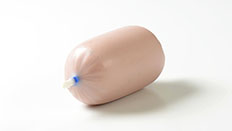Meats and Sausages
Androja Sausage
Androja is a sausage that can be found in the beautiful Eastern Leon Mountain (Montaña Oriental Leonesa) region (previously known as Montaña de Riaño) in the Leon province of Spain. The sausage is made with fat and flour, the practice which is not entirely new. Russians often added to sausages a few percent of potato flour to improve binding. Portuguese Farinheira sausage consists of equal parts of wheat flour and pork belly. Androja is somewhat similar to American Indians product known as pemmican which was made from buffalo fat, finely shredded dry meat and dry herbs and berries, however, flour was not added. If stored in a cool place Androja will keep for months so it is a good survival food.
| Materials | Metric | US |
|---|---|---|
| Lard | 350 g | 0.77 lb |
| Water | 45 ml | 3 Tbsp |
| Pimentón, sweet | 30 g | 5 Tbsp |
| Pimentón, hot | 25 g | 4 Tbsp |
| Wheat flour | 550 g | 1.21 lb |
Ingredients per 1000g (1 kg) of materials
| Salt | 6.0 g | 1 tsp |
Instructions
- Applying little heat, place water in a skillet, then add lard and melt it down. Add salt and pimentón and start slowly adding flour mixing continuously. Mix fat with flour until flour is well absorbed. Add more flour or fat f needed, the result is a lumpy crude mass. This is like making "roux" - a thickening agent for gravy, sauces, soups and stews, commonly used in Cajun and Creole cooking.
- Stuff into 60 mm diameter casings.*
- Cook in water at 80° C (176° F) for 60 minutes. Cooked Androja keeps very well.
Notes
* Fresh Androja (stuffed, but not cooked) can be kept for a short time in refrigerator or frozen for later. It can be stuffed into parchment paper, aluminum foil or cloth bag. Then, it can be cut in slices and fried with eggs for breakfast.
Androja can be stuffed in cabbage leaves, laced up with twine and steamed or baked.
One teaspoon of dry herbs such as oregano, thyme or marjoram can be added.
Androja can be stuffed in cabbage leaves, laced up with twine and steamed or baked.
One teaspoon of dry herbs such as oregano, thyme or marjoram can be added.


















